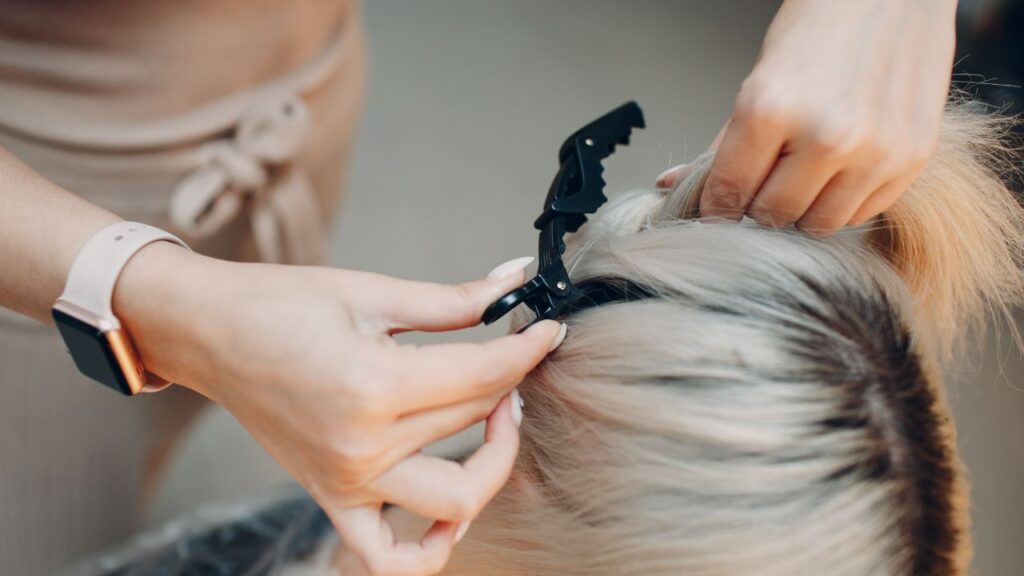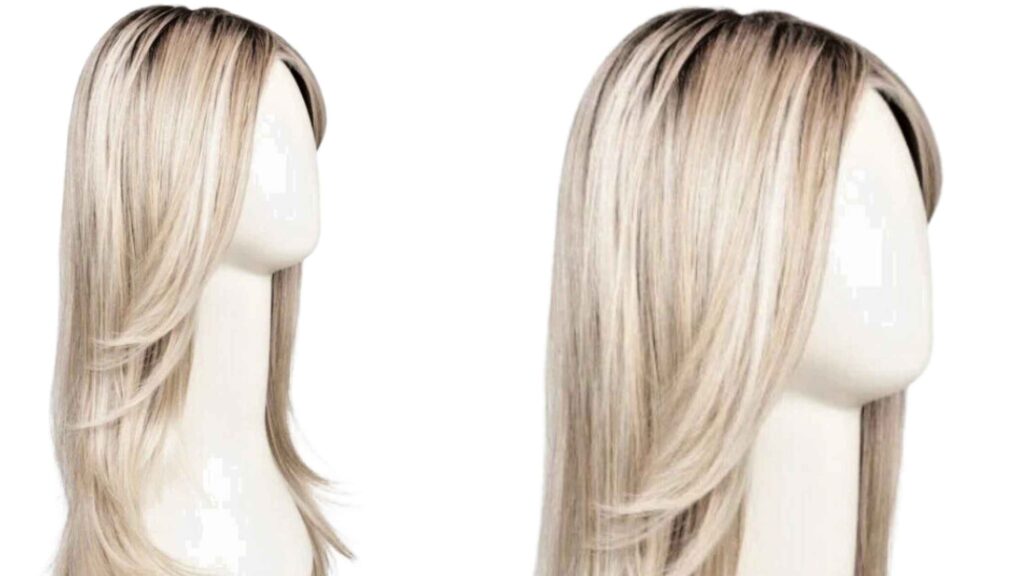Can Synthetic Wigs Be Dyed?
Technically yes, but should you do it?

Is It Okay To Dye Synthetic Wigs?
Whether you have short or long synthetic wigs or a synthetic wig with bangs, you may want to change the product’s look to make it look more realistic, by changing its color. This is why it is important to know whether you can dye your synthetic hair wigs.
So, let’s dive into the world of dyeing synthetic wigs and whether or not you should do it.
Can Synthetic Wigs Be Dyed?
We all love to give ourselves a makeover to enjoy a better look or feel good about ourselves. Dyeing is one of the common things that women invest in to enjoy new looks.
No, synthetic wigs typically cannot be dyed with traditional hair dyes.
Synthetic wig fibers are made from materials like Kanekalon or Toyokalon, which do not readily absorb hair dye. Attempting to dye a synthetic wig with regular hair dye can result in unpredictable and often unsatisfactory outcomes.
There are specially formulated wig dyes available, but even then, the results can be inconsistent. It’s generally recommended to choose a synthetic wig in the desired color or style rather than attempting to dye it.

Can You Bleach Synthetic Wigs?
Many women have a misconception that you can bleach your synthetic hair wigs. That is not true. Even the best synthetic wigs cannot be bleached because artificial hair can only take up darker colors and not from a regular human hair dye.
Even when you are dyeing your synthetic wigs with fabric dye, you must ensure the dye is darker than the wig’s actual color.
How to Dye and Add Roots to a Synthetic Wig
(If you really want to try!)
You might be wondering, “Can you really do this?” Well, guess what? If you really want it, it’s absolutely possible! In this step-by-step tutorial, we’ll show you how to dye a synthetic wig and add roots to make it uniquely yours.
BUT REMEMBER: you can only change the color of a synthetic wig from lighter to darker! You might be curious about lightening up a synthetic wig, but here’s the deal – synthetic wigs can’t be bleached. This means your dye needs to be darker than your wig’s current shade. Typically, white wigs, blonde wigs, silver wigs and pastel wigs are good candidates for a vibrant transformation.
So, let’s get started!

Supplies You’ll Need To Add Roots To Your Synthetic Wig:
- RIT Dye More for Synthetics in Chocolate Brown
- Alcohol-based permanent marker (Sharpie)
- Foil
- Cling wrap
- Paintbrush
- Rubbing alcohol
- Boiling water
- Cellophane
- Mannequin head
1: Prepping the Wig
- Start by pinning your wig onto a mannequin head.
- Section off the top layer of wefts, about three wefts deep. These are the most visible and will make a significant difference in your wig’s appearance.
2: Applying the RIT Dye
- Mix equal parts of boiling water with RIT Dye More for Synthetics (Chocolate Brown).
- Apply the dye to the root area, focusing on the top layers.
- Let gravity do some work; the dye will naturally seep down the strands. Ensure that the roots get plenty of dye by repeatedly applying it to the root area for about 10 minutes.
- Protect your workspace from potential drips, and wrap the wig in cellophane. Let it sit for 30 minutes to allow the color to process.
3: Rinsing
- Rinse the wig thoroughly with cold water to remove excess dye.
- Apply a silicone mix deep conditioner and a Conditioning Spray to keep the wig in great condition.
4: Adding Darker Roots With A Permanent Marker
- Now, it’s time to add deeper roots. Use an alcohol-based permanent marker (COPIC marker in Dark Bark or similar).
- Color in a section of roots, about an inch long, avoiding the track line.
- Follow this up by lightly dipping a paintbrush in rubbing alcohol and using it to extend and blend the color to create a natural, uneven look.
- Work weft by weft, continuing to add the root color and blending it with alcohol. Take your time; it’s worth the effort.
5: Final Touches
- Rinse the wig again with cold water.
- Follow up with your regular conditioning regimen.

How To Fully Dye Your Synthetic Wig
The go-to product for this endeavor is again, with Rit DyeMore, but let’s get a bit deeper into the process with some valuable tips and tricks.
Choosing the Right Rit Dye:
Before we dive into the dyeing process, it’s crucial to understand that there are two types of Rit dyes available:
Rit All-Purpose Dye: This one is your go-to for natural fabrics like cotton or linen.
Rit DyeMore: Specifically crafted for synthetic fabrics, this is the superstar when it comes to wig and hair extension transformations.
Now that we’ve got the basics down, let’s talk materials:
Materials You’ll Need:
Synthetic Hair Extension, Hair Topper, or Wig: Ensure your hairpiece can withstand the dyeing process without damage, this tutorial is only for synthetic fibers!
Rit DyeMore: This is your magical elixir for synthetic material transformation.
A Large Pot Filled with Water: You’ll need a sizable pot to accommodate your hair comfortably.
Stove: To heat things up, quite literally.
Tongs: To handle your wig safely during the dyeing process.
Now, let’s dive into the coloring steps:
Heat the Water: Get started by heating the water in your large pot. You want it hot but not boiling; a simmer is perfect.
Add the Rit DyeMore: Once your water is simmering, it’s time to introduce your Rit DyeMore. Follow the instructions on the dye’s packaging for the right amount.
Prepare Your Hairpiece: Before taking the plunge, dampen your synthetic hairpiece. This helps the dye distribute evenly.
Immerse and Soak: Gently place your wig or extensions into the pot with the simmering Rit DyeMore. Make sure everything is submerged.
Remove from Heat: After about 5 to 10 minutes, remove the pot from the heat source. This duration can vary based on how deep you want the color to be, so keep an eye on it.
Rinse and Rinse Again: Using tongs, carefully take your hairpiece out of the pot. Rinse it thoroughly under running water until you see the excess dye wash away.
Air-Dry and Style: Allow your newly colored synthetic hair to air-dry completely before you start styling. This ensures the color sets in beautifully.
Extra Tips and Tricks:
Test Strands: If you’re unsure about the final color, consider doing a strand test on a small, inconspicuous section of the wig or extensions before the full dyeing process.
Protect Your Workspace: Cover your work area with plastic or old towels to prevent any dye mishaps.
Patience is Key: Achieving the perfect color may take some trial and error. Don’t rush the process, and be prepared for multiple attempts if needed.
Conditioning: After dyeing, use a wig-specific conditioner to keep your synthetic hairpiece looking and feeling fantastic.
Conclusion: Congratulations! You’ve successfully dyed and added roots to your synthetic wig, achieving that perfect color you desired. It’s a bit of a crafty process, but the results are well worth it.
Why Should You Avoid Dyeing Synthetic Wigs?
Here are some reasons to avoid dyeing your high-quality synthetic wigs:
1. It Can Make Your Synthetic Hair Wigs Rough
Synthetic hair wigs are mainly made of natural or artificial polymers. Some products may also be made using acrylics and modified plastics such as PVC or polyester. Hair prepared from these materials is sensitive to dyes.
This is why they become rough when a dye is applied. You may not like the feel of your wig after the process. People may also be able to identify more easily that you’re wearing a synthetic.
So it is ideal to avoid dyeing your high-quality synthetic wigs. Instead, you can buy new wigs in different colors or with streaks for more styling flexibility.
2. Synthetic Hair Wigs Don’t Last Long After Dyeing
Even dyeing natural hair reduces hair quality and damage fibers, which can lead to excessive hair loss. Similarly, synthetic wig strands also suffer root damage upon dyeing. The hair quality and volume of your wig may appear less.
Strands may also break off, which can lead to gaps in the synthetic wig. The overall outcome of these things will be reduced durability of your synthetic product.

3. The Dye Will Not Hold For Long
Synthetic hair wigs are not like human hair, which means that the dyeing process with fabric dye won’t be as efficient. Sometimes, the color may not appear properly even if you follow all the correct steps. This is because it is difficult for artificial polymers to take color.
The dye may also fade within a few washes because synthetic wigs don’t contain natural pigments like real hair. Remember, these pigments are what allow your hair to take up the dye’s coloring.
Closing Thoughts: Can Synthetic Wigs Be Dyed?
This is all you need to know about how can you dye synthetic wigs. You can do that, but it is not recommended so that your product can last longer.
